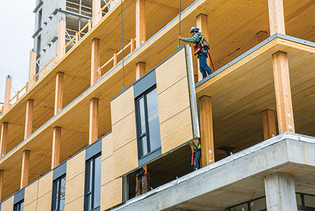 loading
loading
FindingsThe log cabin grows upNew techniques in wood construction can save money and reduce carbon emissions.  Stephane Groleau/Courtesy of Think GoodView full imagePeople are doing two troubling things at once: they are changing the climate through emission of huge quantities of greenhouse gases, and they are rushing into cities and their outskirts. The United Nations projects 2.3 billion new urban dwellers by 2050. So why not tackle both challenges at once? “What we promote in our piece is the use of mass timber for midrise buildings in urban centers,” says Barbara Reck, coauthor of a recent article in Nature Sustainability. Timber could provide lots of housing in the form of 4- to 12-story residential buildings—and a “double carbon benefit,” she adds. Reck, a senior research scientist at the School of Forestry and Environmental Studies (soon to be known as the School of the Environment), explains: “By using timber, you avoid the emissions related to the production of mineral-based materials, like steel and concrete; and then you also have your wooden buildings serving as a carbon sink, where the carbon is hopefully stored for the next 50 to 100 years.” Recent breakthroughs in timber technology make this proposal possible. One relatively new product, glue-laminated timber, can be used to replace vertical support beams. Another, cross-laminated timber, can do the same for flooring. “To make this happen, building codes needed to be adjusted,” Reck says. “And to do that regulators needed to be convinced that the mechanical and structural properties can be met, as well as fire-resistance demands.” (They can.) Governments and industry also need to be educated on the availability and the benefits of wood substitutes. Constructing a 12-story building out of conventional materials is often a months-long process, Reck notes; the building is raised onsite, foot by foot. But “a mass timber building can go up in a matter of weeks,” she says. Prefabrication companies create every piece of wood on demand, and then deliver where needed. “That’s why it’s called building assembly instead of construction. And this is a major cost reduction.”
The comment period has expired.
|
|